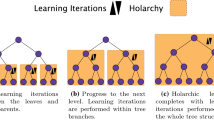Abstract
Extending the current Internet with interconnected objects and devices and their virtual representation has been a growing trend in recent years. The Internet of Things (IoT) contribution is in the increased value of information created by the number of interconnections among things and the transformation of the processed information into knowledge for the benefit of society. Benefit due to the service controlled by communication between objects is now being increased by people who use these services in real life. The sensors are deployed to monitor one or more events in an unattended environment. A large number of the event data will be generated over a period of time in IoT. Hence, the load balancing protocol is critical considerations in the design of IoT. Therefore, we propose an agent Loadbot that measures network load and process structural configuration by analyzing a large amount of user data and network load, and applying Deep Learning’s Deep Belief Network method in order to achieve efficient load balancing in IoT. Also, we propose an agent Balancebot that processes a neural load prediction algorithm based on Deep Learning’s Q-learning method and neural prior ensemble. We address the key functions for our proposed scheme and simulate the efficiency of our proposed scheme using mathematical analysis.



Similar content being viewed by others
References
Ashton, K.: That “Internet of Things”. RFiD J. 22, 97 (2009)
Sundmaeker, H., Guillemin, P., Friess, P., Woelfflé, S.: Vision and Challenge for Realising the Internet of Things. Cluster of European Research Projects on the Internt of Things-CERP IoT (2010)
ITU Internet Reports, the Internet of Things (November 2005)
Atzoti, L., Iera, A., Morabito, G.: The Internet of Things: a survey. Comput. Netw. 54, 2787–2805 (2010)
IBM, Bringing Big Data to the Enterprise. http://www-01.ibm.com/software/data/bigdata/. Accessed 10 July 2012
Giusto, D., Iera, A., Morabito, G., Atzori, L. (eds.): The Internet of Things. Springer, New York (2010). ISBN: 978-1-4419-1673-0
http://net.com/blog/2014/04/22todays-earth-day-tomorrow-shold-be-too
Qin, W., et al.: RestThing: a Restful Web service infrastructure for mash-up physical and Web resources. In: Proceedings of the EUC 2011, 197–204 (2011)
Vega-Barbas, M., Casado-Mansilla, D., et al.: Smart spaces and smart objects interoperability architecture (S3OiA). In: Proceedings of the IMIS 2012, 725–730 (2012)
Gao, L., Zhang, C., et al.: RESTful Web of Things API in sharing sensor data. In: Proceedings of the ICITST 2011, 1–4 (2011)
Wang, H.-I.: Constructing the Green Campus within the Internet of Things architecture. J. Distrib. Sens. Netw. 1–8 (2014)
Weiss, M., Guinard, D.: Increasing energy awareness through web-enabled power outlets. In: Proceedings of the MUM 2010, 20–30 (2010)
López-de-Armentia, J., Casado-Mansilla, D., López-de-Ipiña, D.: Reducing energy waste through eco-aware every-day things. J. MIS 10(1), 79 (2014)
Hasan, M., Hossain, E., Niyato, D.: Random access for machine-to-machine communication in LTE-advanced networks: issues and approaches. IEEE Commun. Mag. 51(6), 86–93 (2013)
CATT, Access control of mtc devices (r2-100182) Technical Report (2010)
Phuyal, U., Koc, A., Fong, M.-H., Vannithamby, R.: Controlling access overload and signaling congestion in M2M networks. Asilomar conference on signals, systems and computers, 2012, pp. 591–595
Galinina, O., Turlikov, A., Andreev, S., Koucheryavy, Y.: Stabilizing multi-channel slotted aloha for machine-type Communications. In: IEEE ISIT, pp. 2119–2123 (2013)
Duan, S., Shah-Mansouri, V., Wong, V.: Dynamic access class barring for M2M communications in LTE networks. IEEE global communications conference (GLOBECOM), pp. 4747–4752 (2013)
Wu, H., Zhu, C., La, R., Liu, X., Zhang, Y.: FASA: accelerated S-ALOHA using access history for event-driven M2M communications. IEEE/ACM Trans. Netw. 21(6), 1904–1917 (2013)
Cheng, M.Y., Lin, G.Y., Wei, H.Y., Hsu, A.C.: Overload control for machine-type-communications in LTE-Advanced system. IEEE Commun. Mag. 50(6), 38–45 (2012)
3GPP, Study on RAN improvements for machine-type communications (release 11), Technical Report (2011)
Krizhevsky, A., Sutskever, I., Hinton, G.: Imagenet classification with deep convolutional neural networks. In: Advances in Neural Information Processing Systems, vol. 25, pp. 1106–1114 (2012)
Barto, A., Konidaris, G.: Applying deep belief networks to the game of Go. In: MIT Press (May 2010)
Artaro, L., Perez, Q.: A model for general video game learning. Desseration for Master Degree of Universidad Nacional De Colombia (May 2016)
O’Connor, P., Neil, D., Liu, S.C., Delbruck, T., Pfeiffer, M.: Real-time classification and sensor fusion with a spiking. Front. Neurosci. vol. 17, pp. 61–73, October 8, 2013. Article ID 178
Salama, M.A., Hassanien, A.E., Fahmy, A.A.: Deep belief network for clustering and classification of a continuous data. The 10th IEEE international symposium on signal processing and information technology, pp. 472–477, Dec 2010
Maei, H., Szepesv’ari, C., Bhatnagar, S., Sutton, R.S.: Toward off-policy learning control with function approximation. In: Proceedings of the 27th international conference on machine learning (ICML 2010), pp. 719–726 (2010)
Yu, L., Yang, Z., Tang, L.: A novel mutistage deep belief network based extreame learing machine ensemble learning paradigm for credit risk assessment. In: Flexible Services and Manufacturing Journal, pp. 1–17, September 29, 2015
Liu, F., Liu, B., Sun, C., Liu, M., Wang, X.: Mutimodal deep belief network based link prediction and user comment generation. In: ICONIP 2015, pp. 20–28
van Hasselt, H., Guez, A., Silver, D.: Deep reinforcement learning with double Q-Learning. In: Proceedings of the thirtieth AAAI conference on artificial intelligence (2015)
Wang, X.L., Chen, Y.Y., Zhao, H., Lu, B.L.: Parallelized extreme learning machine ensemble based on min–max modular network. In: Neurocompting, vol. 128, pp. 31–41, March 29, 2014
Acknowledgements
This research was supported by Basic Science Research Program through the National Research Foundation of Korea (NRF) funded by the Ministry of Science, ICT & Future Planning (No. 2016RIA2B4012386) and this work was supported by 2016 Hongik University Research Fund.
Author information
Authors and Affiliations
Corresponding authors
Rights and permissions
About this article
Cite this article
Kim, HY., Kim, JM. A load balancing scheme based on deep-learning in IoT. Cluster Comput 20, 873–878 (2017). https://doi.org/10.1007/s10586-016-0667-5
Received:
Revised:
Accepted:
Published:
Issue Date:
DOI: https://doi.org/10.1007/s10586-016-0667-5




